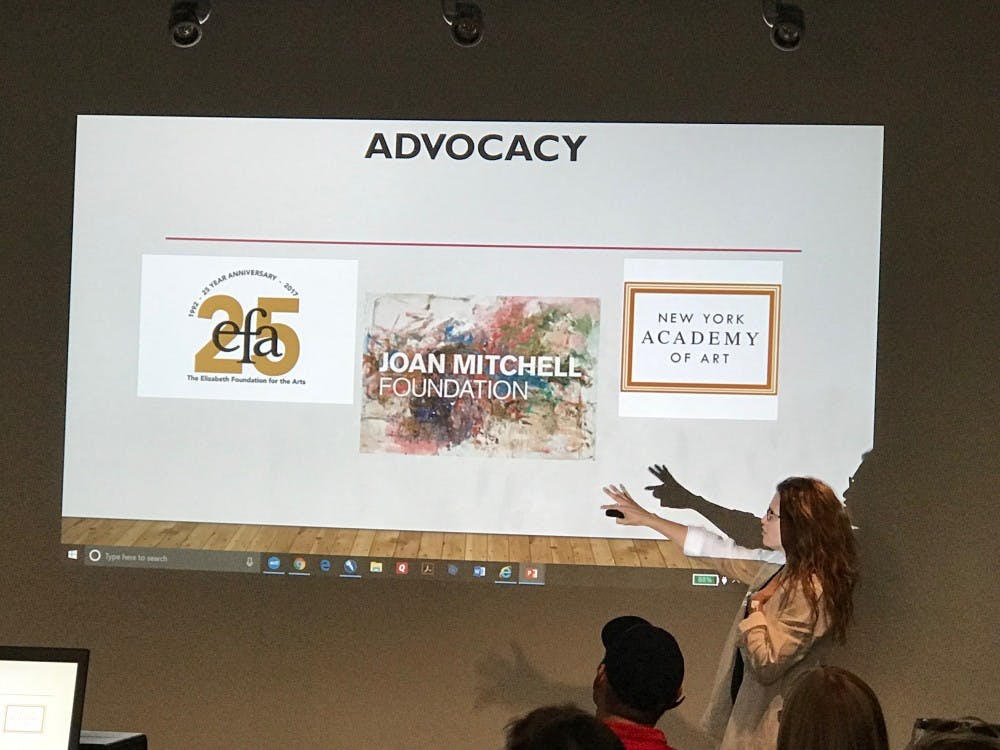Students, particularly in art programs, look for ways to bridge the gap between being creative and being successful.
This is a key theme in a new book edited by artist Sharon Louden entitled "The Artist as Culture Producer."
The book contains a collection of essays by 40 visual artists, according to the book's website. It describes how artists practice their craft outside their studios and how they act as artistic change agents in their communities.
Through their innovation and contribution, the book aims to show how contemporary artists in the 21st century add to their creative economy and discuss the misconceptions of artists, the website said.
Louden spoke on this concept and the book at “The Artist as Culture Producer," to ASU students at Grant Street Studios earlier this week.
She also discussed the challenges of being a successful artist and creator.
“To me, sustainability doesn’t just mean financial (success),” Louden said. “(Artists) show ways in which they show their creative life.”
Louden recounted her earlier days when she made cold calls to contribute to her community, citing organizations like the Ford Foundation and Artists Thrive. The book is a culmination of the artists she has met, or at least heard from, over the years.
“Half the people in the book I’ve never met,” She said “I want to created a community; the book is the platform.”
Linda Essig, director of the Herberger Institute Enterprise and Entrepreneurship Programs, said that she had known Louden’s work for some time before the artist came to speak.
“Her first collection of artist essays, Living and Sustaining a Creative Life, has been on the recommended reading list for arts entrepreneurship students for some time,” Essig said. “I have recommended it to the faculty who teach professional practices courses within the School of Art.”
Essig also said that Louden had previously worked with Herberger Institute for Design and Arts Dean Steven Tepper when he was at Vanderbilt University.
Tepper co-hosted the forum and also spoke about the divide between creativity and success that students might face.
“Part of it is definition and self interpretation,” Tepper said.
This includes coping with the negative stigmas that have arose over the years, Tepper said, such as that artists don't care about making money, or that they are individualistic.
“(They are) all mythologies,” he said.
Tepper said that acknowledging the community and using the available resources will be the way that artists will shake off those negative stigmas that pop culture has ingrained in many people.
The book shows how artists are working around the world. Of the 180,000 graduates who were surveyed, students with a BFA in art were represented in nearly 3,000 different positions, according to a study by Tepper.
“Think of the creative skills they have,” Tepper said. “Create, improvise, engage.”
Tepper asked students what they could do with this information.
“What does it mean to have a creative identity?” he said. “What we found is in non-arts occupations, there are a sizable amount of graduates. (They say) I can be creative in non-arts jobs.”
Tepper said that the key for the artist is to know who they are speaking to and how to speak their language, and know what they want to advance.
“Artists add to the combustible energy,” he said. “City agencies have artists embedded in them. Science labs as well.”
To this end, Tepper said that the top thing he would implement into education programs is professional development.
Louden echoed the statement of updating and implementing education programs.
“I wanted contemporary examples instead of the typical professor,” she said.
Communication is important, and success will come from a community, Louden said.
“Think about the public happiness,” she said.
Reach the reporter at cmbegaye@asu.edu and follow @Hoagmaster91 on Twitter.
Like The State Press on Facebook and follow @statepress on Twitter.




